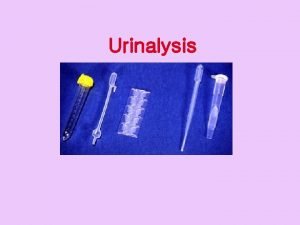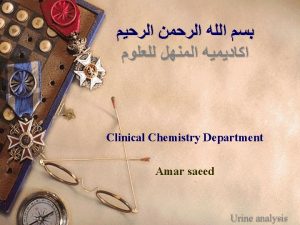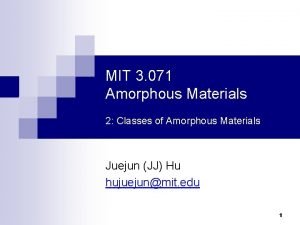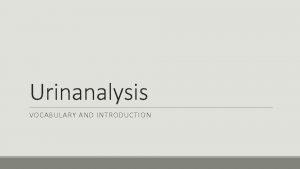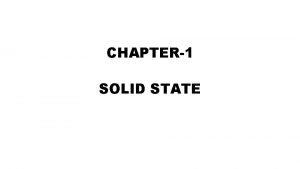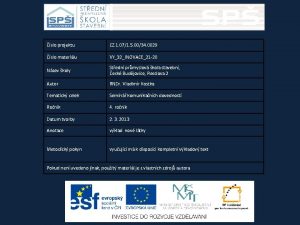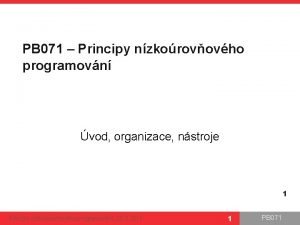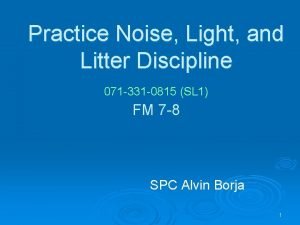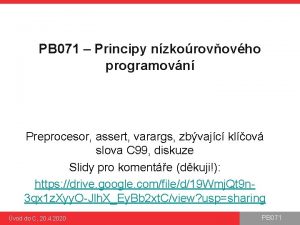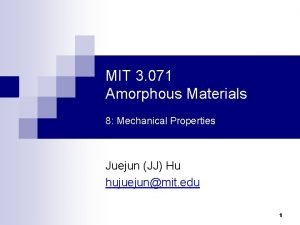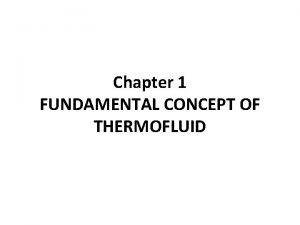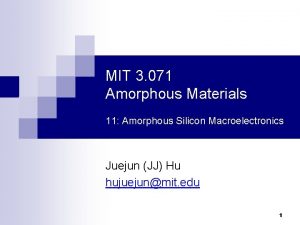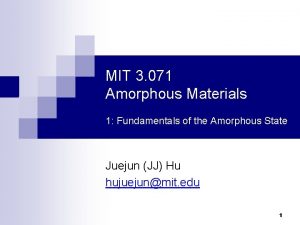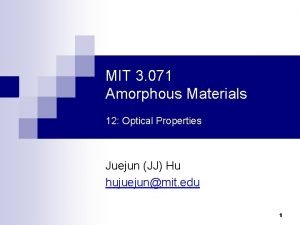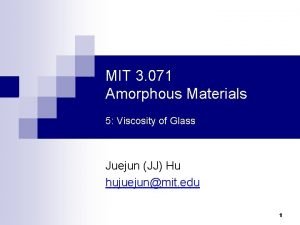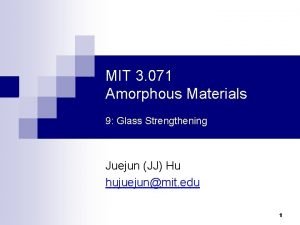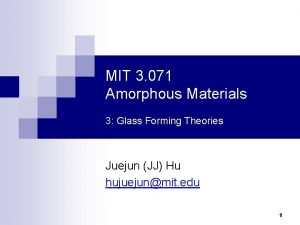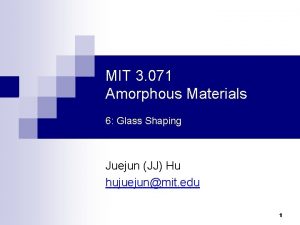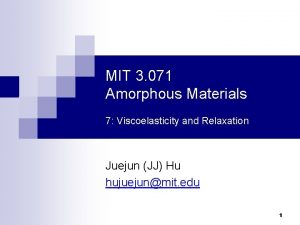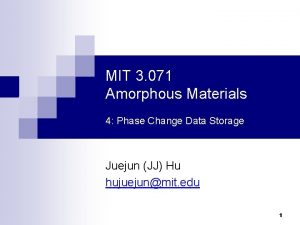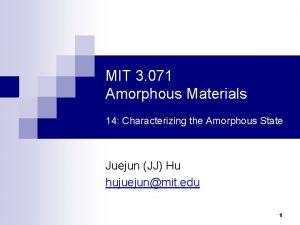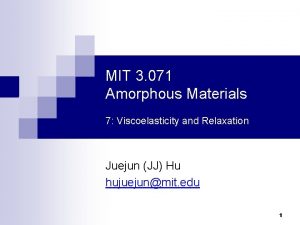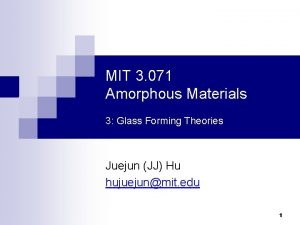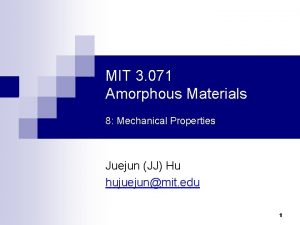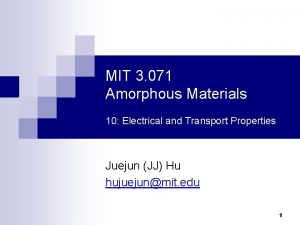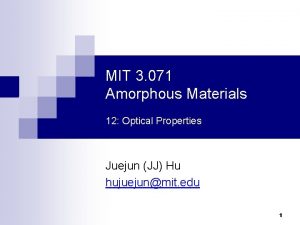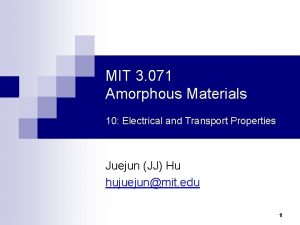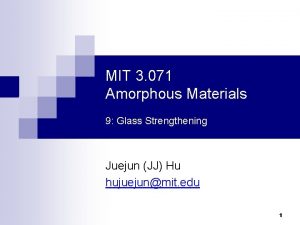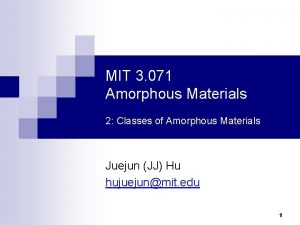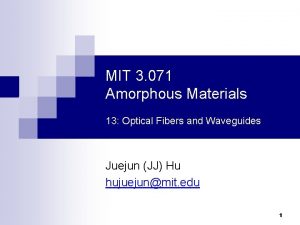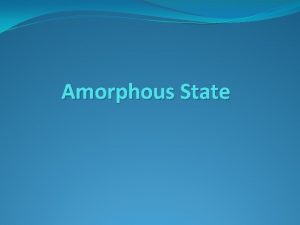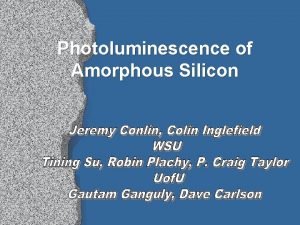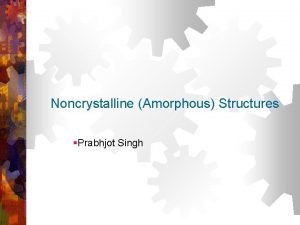MIT 3 071 Amorphous Materials 1 Fundamentals of


































- Slides: 34

MIT 3. 071 Amorphous Materials 1: Fundamentals of the Amorphous State Juejun (JJ) Hu hujuejun@mit. edu 1

Contact Information n Juejun (JJ) Hu, Rm 13 -4054 n hujuejun@mit. edu n Ph: (302) 766 -3083 n Research interests We work with light ¨ Optics & photonics ¨ Novel optical materials (including amorphous materials) ¨ ¨ Chem-bio sensing, flexible optoelectronics, optical imaging, biomedical optics, photovoltaics, magneto-optics, data communications, … 2

References n n Fundamentals of Inorganic Glasses ¨ Arun K. Varshneya, Academic Press (1994) ¨ Google Books, MIT Library Introduction to Glass Science and Technology ¨ James E. Shelby, Royal Society of Chemistry (2005) ¨ RSC Publishing (paste link to a browser window), MIT Library Glass Science, 2 nd Edition ¨ Robert H. Doremus, Wiley (1994) ¨ MIT Library Springer Handbook of Glass ¨ J. D. Musgraves, J. Hu, L. Calvez (Eds. ), Springer (2018) 3

Class organization n n Modules ¨ Lectures: MW 2: 30 -4 (4 -153) ¨ Guest Lectures ¨ In-class demos ¨ MIT Glass lab: special thanks to Peter Houk & Prof. Cima ¨ Final project presentation ¨ 2 -3 individual project meetings Stellar site ¨ Syllabus, announcements, lecture slides, assignments, solutions will be posted on Stellar ¨ Fall 2017 Stellar Link 4

Grading policy n In-class quizzes: 10% n Homework assignments: 30% ¨ n Discussions are allowed and encouraged; but you are supposed to complete the assignments independently Design review project: 60% ¨ Project proposal: 20% ¨ Term paper: 25% ¨ Final presentation: 15% 5

Important dates n n Nov. 6 project proposal due ¨ Page limit: 5 (including figures & tables, excluding references); Font: Times New Roman 12; Page format: letter size with 1 inch margin ¨ Motivation and significance; Brief review of state-of-the-art; Proposed technical approach; Anticipated outcome ¨ 1 executive summary slide Dec. 11/13 project presentation ¨ Time limit and format: TBD 6

Important dates n n Dec. 15 term paper due ¨ Page limit: 8 (including figures & tables, excluding references); Font: Times New Roman 12; Page format: letter size with 1 inch margin ¨ Motivation and significance; Current state-of-the-art; Research methodology; Results and discussion; Conclusions Document templates/examples will be posted on Stellar 7

Project topic examples Glass box cracks at 1, 353 feet above: is it still safe? Can we make smart phones smarter with built-in photonics? Opt. Express 22, 15473 (2014). Are smart windows technologically and economically viable? Where is my metallic glass cased i. Phone? 8

Evaluation criteria n n Proposals and papers ¨ Intellectual merit (75%): soundness, depth, thoroughness, inventiveness ¨ Presentation (25%): logical coherence, clarity, conciseness In-class presentation ¨ Timing (20%) ¨ Presentation (40%): logical coherence, clarity, conciseness ¨ Intellectual merit (40%): soundness, depth, thoroughness, inventiveness 9

What is glass (amorphous solid)? 10

11

12

What is glass (amorphous solid)? n Mechanical properties Brittle, fragile, stiff n Optical properties Transparent, translucent “A room-temperature malleable glass” (As 60 Se 40) Video courtesy of IRradiance Glass Inc. 13

What is glass (amorphous solid)? n Electrical properties Insulating n Chemical properties Metallic glass Durable, inert Man-made q q q Obsidian (volcanic activity) Tektite (meteorite impact) Fulgurite (lightning strike) NASA: Galileo Spacecraft found amorphous ice on moons of Jupiter 14

Amorphous materials are ubiquitous n Glass cover n Camera lens n TFT display n Dielectrics n Circuit packaging ? Metallic glass case ? Phase change memory ? Solid state battery and many more… 15

What is amorphous solid (glass)? n E A metastable solid with no long-range atomic order (and exhibiting glass transition) Metastable glassy state Thermodynamically stable crystalline state ü Glasses are metastable with respect to their stable crystalline phase ü Atoms can rearrange to form a more stable state given enough time and thermal energy Structure 16

What is amorphous solid (glass)? n A metastable solid with no long-range atomic order (and exhibiting glass transition) Consider a fictitious A 2 O 3 2 -D compound: A 2 O 3 crystal A 2 O 3 glass ü Short-range order is preserved (AO 3 triangles) ü Long-range order is disrupted by changing bond angle (mainly) and bond length ü Structure lacks symmetry and is usually isotropic Zachariasen's Random Network Theory (1932) 17

Glass consists of a continuous atomic network n Absence of small angle scattering ¨ n Continuous structure without micro-voids Broad diffraction peak ¨ Size of ordered region < 8 Å (Scherrer equation) ¨ Unit cell size of cristobalite: 7. 1 Å Glass is NOT a collection of extremely small crystals J. Am. Cer. Soc. 21, 49 -54 (1938). 18

Random network model of silica glass (Si. O 2) Radial distribution function Nature 212, 1353 (1966). Now in the Science Museum, London Excellent agreement between XRD and ball-and-stick model constructed according to the random network model 19

Direct atomic imaging of bilayer silica glass O Si O 2 -D projection Quartz crystal Si-O tetrahedron 20

Direct atomic imaging of bilayer silica glass STEM images of 2 -D silica crystal and glass Sci. Rep. 3, 3482 (2013). Nano Lett. 12, 1081 -1086 (2012). 21

Glass formation from liquid V, H Liquid When the system is kept in thermal equilibrium: ü First-order liquid-solid phase transition ü Discontinuity of extensive thermodynamic parameters (e. g. , V and H) ü Reversible process Melting / solidification Crystal Tm T 22

Glass formation from liquid V, H Supercooled liquid Liquid Glass transition Glass Crystal Tf Tm ü Supercooled liquid transforms to the glassy state when crystallization is kinetically suppressed ü Extensive variables remain continuous during glass transition ü The glassy state is different from supercooled liquid ü Tf : Fictive temperature T 23

Glass formation from liquid V, H Supercooled liquid Liquid Increasing cooling rate 3 2 1 Tm ü Glasses obtained at different cooling rates have different structures ü With increasing cooling rate: v V 1 < V 2 < V 3 Free volume increases v H 1 < H 2 < H 3 Configurational entropy increases v Tf, 1 < Tf, 2 < Tf, 3 T 24

Glass formation from liquid V Supercooled liquid Liquid The heating curve never retraces the cooling curve during glass transition due to structural relaxation Tm T 25

What is amorphous solid (glass)? n A metastable solid with no long-range atomic order (and exhibiting glass transition) Liquid: atoms do not have fixed positions; bonding constraints relax as temperature rises Solidification Melt quenching Melting Crystal: atoms arranged with both short range and long range order Softening Crystallization Amorphization (vitrification) Glass: atoms arranged with short range order but lack long range order 26

What is amorphous solid (glass)? A metastable solid with no long-range atomic order (and exhibiting glass transition) Normalized distribution n Si-O-Si bond-bending constraint is relaxed at the forming temperature of silica glass 144°: Si-O-Si bond angle in a-quartz Si-O-Si bond angle distribution in silica glass measured by XRD J. Appl. Cryst. 2, 164 (1969) Si-O-Si bond angle in fused silica 27

Quantitative description of glass structure n Structural descriptions of amorphous materials are always statistical in nature n Pair distribution function (PDF): g(r) ¨ Consider an amorphous material with an average number density of atom given by: n : number of atoms V : material volume ¨ The number density of atoms at a distance r from an origin atom is given by ¨ When 28

PDFs of ideal (hard sphere) crystals vs. glasses g(r) 1 st coordination shell 2 nd coordination shell r g(r) 1 0 r 29

Quantitative description of glass structure n Pair correlation function h(r) ¨ n Radial distribution function (RDF): J(r) ¨ n ¨ J(r)dr gives the number of atoms located between r and r + dr away from the origin atom ¨ The area under the RDF curve gives the number of atoms Reduced radial distribution function (r. RDF): G(r) ¨ 30

Summary Supercooled liquid V n The amorphous state is metastable n Amorphous structures possess short-range order and lack long-range order n Amorphous materials can be obtained from liquid by melt quench n Melt quench is a continuous, irreversible process involving phase change n Glass properties depend on their thermal history Liquid Glass Crystal Tm T 31

Crystalline vs. amorphous 32

Crystalline vs. amorphous 33

After-class reading list n Fundamentals of Inorganic Glasses ¨ n Ch. 1 & 2 Introduction to Glass Science and Technology ¨ Ch. 1 34
 State of matter
State of matter Amorphous urate
Amorphous urate Crystalline vs non crystalline
Crystalline vs non crystalline Power 1 one
Power 1 one Microscopic analysis of urine
Microscopic analysis of urine Oxygen and silicon
Oxygen and silicon Crystalline solid
Crystalline solid Nocturia pronunciation
Nocturia pronunciation Crystalline or amorphous
Crystalline or amorphous Urine
Urine Crystalline solid and amorphous solid
Crystalline solid and amorphous solid Amorphous disk mark
Amorphous disk mark Solid
Solid Perform surveillance without the aid of electronic device
Perform surveillance without the aid of electronic device 071-com-0029
071-com-0029 Pb071
Pb071 Noise and light discipline
Noise and light discipline Foo2123
Foo2123 071-com-4407
071-com-4407 3 minor terrain features
3 minor terrain features N 3^071
N 3^071 ?3305501049 0000 28|.|091 27|.|071 98|.|553 102|.|311 13`
?3305501049 0000 28|.|091 27|.|071 98|.|553 102|.|311 13` 071 atm code
071 atm code 071-com-4407
071-com-4407 How to react to indirect fire
How to react to indirect fire Favourite cars
Favourite cars Direct materials budget with multiple materials
Direct materials budget with multiple materials What is the difference between useful and harmful materials
What is the difference between useful and harmful materials Man made map
Man made map Differentiate adopting materials and adapting materials
Differentiate adopting materials and adapting materials Fluid mechanics fundamentals and applications
Fluid mechanics fundamentals and applications Cs 1101 programming fundamentals final exam
Cs 1101 programming fundamentals final exam Functional programming fundamentals
Functional programming fundamentals Cs 1101 programming fundamentals
Cs 1101 programming fundamentals Fundamentals of thermal-fluidsciences chapter 1 problem 19p
Fundamentals of thermal-fluidsciences chapter 1 problem 19p

